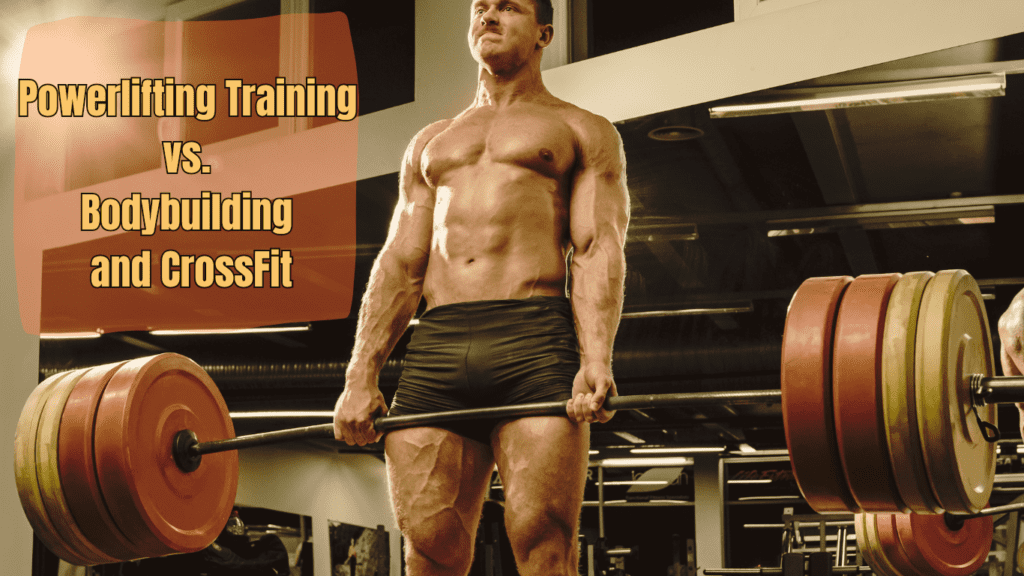How to Train for a Triathlon: Starting Your Journey
It’s incredible how triathlons have gained immense popularity over the past decade. Just last year, there was a remarkable increase in participation, with over 2 million people taking part in various triathlons worldwide. As a personal trainer with a passion for endurance sports, I’ve seen firsthand how this surge in interest is more than just a trend—it’s a testament to the growing desire for comprehensive fitness challenges. I remember my first triathlon vividly; the excitement, the nerves, and ultimately, the profound sense of accomplishment. Today, I want to share with you how to train for a triathlon, breaking it down in a way that’s both accessible and effective.
Triathlons can seem daunting at first, but with the right preparation, anyone can cross that finish line. This guide is designed specifically for beginners to intermediates, providing a practical, step-by-step approach. You’ll find that with consistency, dedication, and the right plan, you’ll be well on your way to your first (or next) triathlon.
When training for a triathlon, the first step is understanding the components: swimming, biking, and running. Each discipline requires unique skills and stamina, and balancing these can be tricky. My approach focuses on integrating all three into your routine seamlessly. Many people I’ve trained started with a strong suit in one area, like running, but needed to build confidence in the others. This guide will help you develop a well-rounded training regimen.

Starting with swimming, it’s often the most challenging part for many. The key is to begin with basic techniques and gradually increase your distance. When I started, I couldn’t swim more than a few laps without getting exhausted. Through structured practice, focusing on form and breathing, I slowly built up my endurance. Aim to swim at least twice a week, incorporating drills that improve your technique and stamina.
Next, we tackle biking. It’s essential to get comfortable with long rides, as this portion often covers the most distance in a triathlon. Start by cycling shorter distances and gradually increase. When I coach, I emphasize the importance of varied terrain to simulate race conditions. Incorporate hill climbs and flat sprints into your routine. Also, invest in a bike that fits well and ensure you’re familiar with basic maintenance—knowing how to fix a flat tire can save your race day!
Subscribe And Get Our Free E-Book:Unlocking The Power Of Nutrition-Supplements, Substitutes, and Superfoods!
Running, often the final leg, can be grueling, especially after swimming and biking. The transition from biking to running, known as a brick workout, is crucial. These sessions involve back-to-back cycling and running workouts to adapt your legs to the transition. Initially, it’s a struggle, but over time, these brick workouts build the necessary endurance and muscle memory.
Equally important as physical training is recovery and nutrition. In my early days, I underestimated the importance of rest, leading to burnout and injuries. Schedule rest days and listen to your body. Proper nutrition fuels your workouts and recovery. Focus on a balanced diet rich in lean proteins, whole grains, fruits, and vegetables. Stay hydrated and consider consulting with a nutritionist to tailor a plan that meets your specific needs.
Let’s not forget the mental preparation. Triathlons are as much a mental challenge as they are physical. Visualize your race day, breaking it down into manageable segments. When I race, I mentally prepare for each part, which helps in staying focused and calm. Meditation and mindfulness exercises can enhance your mental fortitude.
Consistency is key in how to train for a triathlon. Set a training schedule and stick to it, but remain flexible to adjust as needed. Life can throw curveballs, and it’s okay to tweak your plan. The journey is as important as the destination, and each training session brings you a step closer to your goal.
Throughout your training, remember to track your progress. Keep a training journal or use apps to log your workouts. Reflecting on your improvements keeps you motivated and helps identify areas needing more attention. I still look back at my training logs to see how far I’ve come, and it’s incredibly motivating.
In this guide, I’ve outlined a holistic approach to how to train for a triathlon. You’ll learn the intricacies of swimming, biking, and running, balanced with recovery, nutrition, and mental strategies. This journey will be transformative, pushing you beyond your limits and rewarding you with a profound sense of achievement. Whether you’re a beginner or looking to improve, this guide is tailored to help you prepare effectively and confidently. So lace up your shoes, grab your goggles, and let’s dive into this exciting journey together.
How to Train for a Triathlon:Understanding Triathlons
Training for a triathlon starts with understanding the different types of events you might participate in. Each type of triathlon has its unique challenges and distances, and knowing these details is crucial for effective training. When I first started exploring how to train for a triathlon, I found it incredibly helpful to grasp the distinctions between the various formats. Let me walk you through the main types: Sprint, Olympic, Half Ironman (70.3), and Full Ironman.
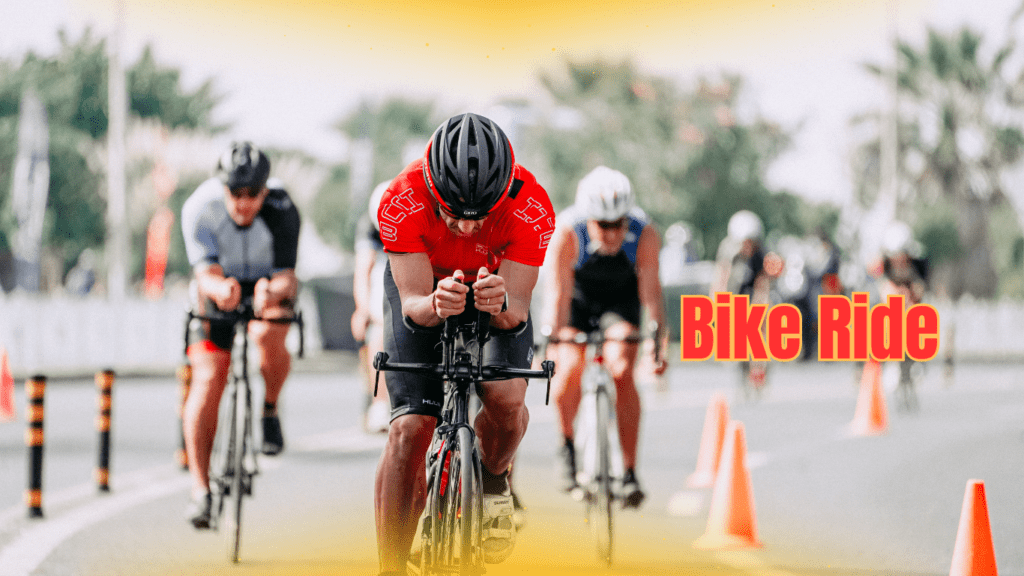
A Sprint triathlon is a great entry point for beginners. The distances typically involve a 750-meter swim, a 20-kilometer bike ride, and a 5-kilometer run. These shorter distances are perfect for those new to the sport, allowing you to get a taste of each discipline without the overwhelming demands of longer races. When I coach beginners, I often recommend starting with a Sprint triathlon because it provides a manageable challenge while still requiring focused training and preparation.
Next, we have the Olympic triathlon, also known as the standard distance. This involves a 1.5-kilometer swim, a 40-kilometer bike ride, and a 10-kilometer run. The Olympic distance is a significant step up from the Sprint, demanding greater endurance and a more comprehensive training regimen. I remember my first Olympic triathlon vividly; it required more strategic training and a better understanding of pacing across each segment. Training for this distance often includes longer, more intense workouts, and it’s an excellent goal for those looking to push beyond the Sprint level.
For those looking to challenge themselves even further, the Half Ironman (or 70.3) is an impressive undertaking. This race includes a 1.9-kilometer swim, a 90-kilometer bike ride, and a 21.1-kilometer run. The name 70.3 comes from the total distance in miles covered in the race. Training for a Half Ironman requires a significant commitment of time and energy. When I trained for my first Half Ironman, I had to carefully balance long endurance sessions with proper recovery to avoid burnout. This distance is ideal for athletes who have completed shorter triathlons and are ready to push their limits.
10 Things I Wish I Knew Before Training For A Triathlon
The Full Ironman is the ultimate triathlon challenge. It consists of a 3.8-kilometer swim, a 180-kilometer bike ride, and a full marathon (42.2 kilometers). Completing a Full Ironman is a monumental achievement and requires months of dedicated training. Preparing for an Ironman means not only building incredible endurance but also honing mental toughness. I’ve guided many athletes through this journey, and the key is a well-structured training plan that incorporates gradual distance increases and proper nutrition strategies. The sense of accomplishment after crossing the finish line of an Ironman is unparalleled.
Beyond understanding the distances and challenges of each type of triathlon, immersing yourself in the triathlon community can provide tremendous benefits. Joining a triathlon club or group offers support, camaraderie, and shared knowledge. When I joined my local triathlon club, I found a network of like-minded individuals who offered encouragement and advice. Training with others can provide motivation, accountability, and sometimes just the right amount of friendly competition to push you further.
Online communities and resources are also invaluable. There are numerous forums, social media groups, and websites dedicated to triathletes. These platforms offer a wealth of information, from training tips and race reviews to advice on gear and nutrition. Participating in these online communities can help you stay informed about the latest trends and connect with triathletes from around the world. When I first started exploring how to train for a triathlon, I spent countless hours on these platforms, soaking up as much information as possible.
The camaraderie and shared experiences within the triathlon community can significantly enhance your training journey. Whether you’re seeking advice, looking for training partners, or simply wanting to share your progress, these connections can provide a sense of belonging and support.
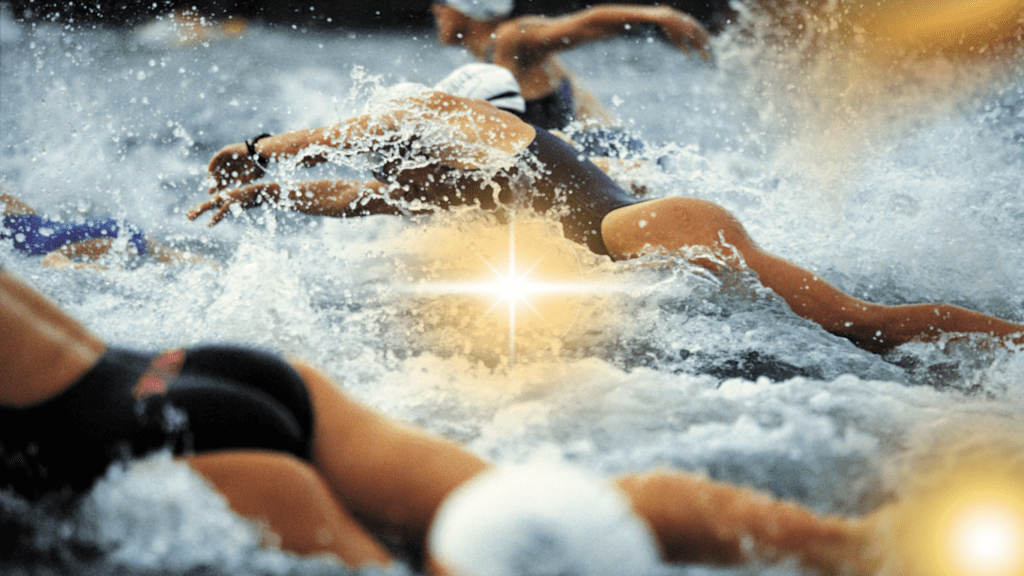
Understanding the different types of triathlons and the community around the sport is crucial when learning how to train for a triathlon. Each type of race, from Sprint to Full Ironman, presents unique challenges that require tailored training approaches. Immersing yourself in the triathlon community, both locally and online, can offer invaluable support and resources. By combining a thorough understanding of the race types with the benefits of community support, you’ll be well-equipped to embark on your triathlon journey with confidence and enthusiasm.
Triathlon Distance Comparison Chart
| Triathlon Type | Swim Distance | Bike Distance | Run Distance | Total Distance |
|---|---|---|---|---|
| Sprint | 750m | 20km | 5km | 25.75km |
| Olympic | 1.5km | 40km | 10km | 51.5km |
| Half Ironman | 1.9km | 90km | 21.1km | 112km |
| Full Ironman | 3.8km | 180km | 42.2km | 226km |
How to Train for a Triathlon: Setting Goals and Planning
When it comes to learning how to train for a triathlon, one of the first and most important steps is setting clear goals and planning your journey. Choosing your race distance is a critical decision that sets the tone for your entire training process. It’s essential to select a distance that aligns with your current fitness level and long-term aspirations. I remember when I was starting, my enthusiasm made me consider a Full Ironman right away, but I quickly realized that setting achievable milestones was key to sustaining motivation and progress.
Choosing Your Distance involves considering several factors. First, honestly assess your current fitness level. If you’re new to endurance sports, starting with a Sprint triathlon might be the best choice. This distance offers a manageable challenge and allows you to gain experience in all three disciplines—swimming, biking, and running—without overwhelming you. On the other hand, if you’ve been active and have some experience in at least one of the triathlon sports, you might aim for an Olympic distance. This provides a more substantial challenge and requires a more structured training plan.
For those who have already completed shorter triathlons and are looking to push their boundaries, the Half Ironman (70.3) is an excellent goal. It’s a significant step up, demanding more time and dedication, but it’s incredibly rewarding. And finally, if you’re an experienced triathlete with a solid training background, the Full Ironman is the ultimate challenge. This race tests the limits of endurance and mental toughness, requiring a comprehensive and rigorous training regimen.
Once you’ve chosen your race distance, the next step in how to train for a triathlon is creating a training plan that is both realistic and flexible. Building a training schedule involves periodization, a systematic approach that cycles through different phases: base, build, peak, and taper. In the base phase, the focus is on establishing a strong aerobic foundation. This period includes low to moderate intensity workouts that gradually build your endurance. When I started training, this phase helped me develop the stamina necessary for more intense future workouts.
The build phase intensifies the training, incorporating higher intensity workouts and longer sessions. This phase is about pushing your limits and improving speed and strength. During this time, I found it crucial to monitor my body’s responses and ensure I wasn’t overtraining, as the risk of injury can increase with higher intensity.
Approaching race day, the peak phase focuses on reaching your maximum performance potential. Workouts become race-specific, simulating the conditions and distances you’ll face on race day. The final phase, tapering, involves reducing the training volume to allow your body to recover and reach optimal condition. I remember how strange it felt to scale back my workouts after months of intense training, but it’s a vital step to ensure you’re fully rested and ready for the race.
Balancing training with other commitments is another significant aspect of how to train for a triathlon. Many of us juggle work, family, and social obligations, and finding time for training can be challenging. Effective time management is key. When I was training for my first Half Ironman, I learned to integrate workouts into my daily routine creatively. Early morning runs or swims, lunch break rides, and combining family time with light recovery sessions became part of my strategy.
To manage your time effectively, consider these tips: prioritize your workouts by scheduling them as you would any important appointment. Use a training calendar to plan your week in advance, and be flexible enough to adjust as needed. Incorporating brick workouts—where you transition from one discipline to another in a single session—can save time and prepare you for race day transitions. Lastly, communicate with your family and involve them in your training journey. Their support can make a significant difference and turn training into a shared experience.
Remember, consistency and balance are key. It’s better to have shorter, consistent workouts than sporadic, intense sessions followed by long breaks. This approach helps maintain steady progress and reduces the risk of burnout or injury.
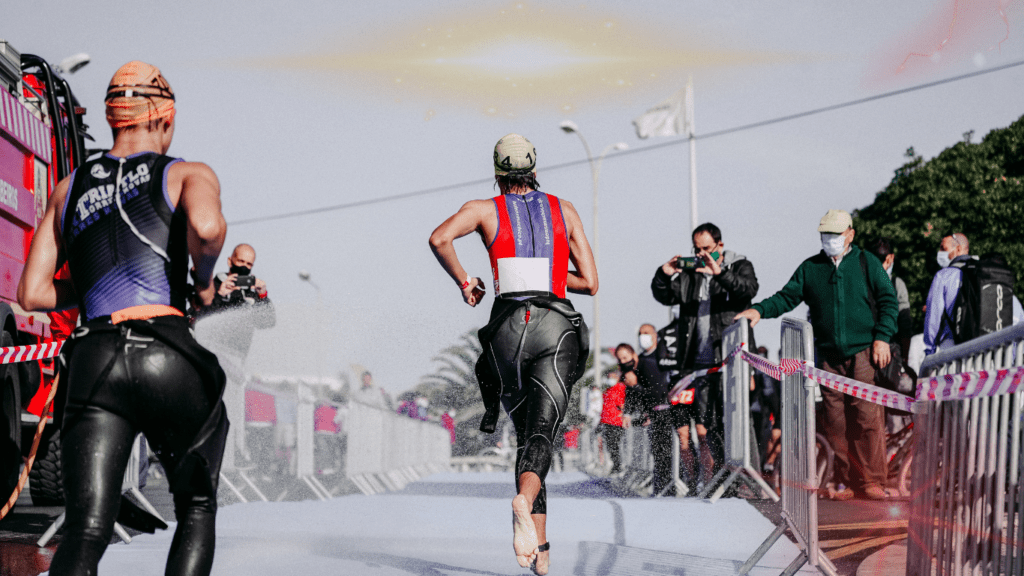
In conclusion, setting goals and planning are fundamental steps in how to train for a triathlon. Choosing the right distance based on your current fitness level, creating a flexible and realistic training plan with proper periodization, and managing your time effectively are all crucial elements. By approaching your training with a clear plan and balanced mindset, you’ll be well on your way to achieving your triathlon goals. Embrace the journey, stay committed, and enjoy the process of becoming a stronger, more resilient athlete.
Training Fundamentals
Training for a triathlon involves mastering three disciplines: swimming, cycling, and running. Each requires specific techniques, gear, and workouts to build the endurance and strength needed to complete a triathlon. When learning how to train for a triathlon, it’s essential to understand the fundamentals of each discipline. Let’s dive into the details, starting with swimming.
Swimming can be intimidating for many beginners, but with the right approach, you can become proficient. The basics start with the right gear: a well-fitting swimsuit, goggles that don’t fog or leak, and a swim cap if you have long hair. Technique is crucial in swimming. Focus on your body position, ensuring you stay streamlined to reduce drag. When I started swimming, I made the common mistake of lifting my head too high, which caused my legs to sink and made me expend more energy. Keep your head in a neutral position, looking straight down, and rotate your body with each stroke to maintain balance and efficiency.
Building endurance and speed in swimming involves specific drills and workouts. Incorporate drills like finger-drag (to improve high elbow recovery) and catch-up (to enhance stroke timing) into your routine. Interval training, where you swim fast for a set distance followed by a recovery swim, helps improve speed. For endurance, gradually increase your swim distance each week. When I first started training, I aimed to add an extra 200 meters every two weeks to my long swim sessions.
Training in a pool versus open water presents different challenges. Pools offer a controlled environment where you can focus on technique without worrying about external factors. However, open water swimming is a different ball game. It requires you to navigate currents, waves, and sometimes poor visibility. Practice sighting by lifting your head periodically to ensure you’re swimming straight. Incorporate open water swims into your training to build confidence and get accustomed to the conditions you’ll face on race day.
Cycling is the next crucial component. Ensuring your bike is a good fit for your body is vital for both performance and comfort. A professional bike fitting can help you avoid injuries and maximize efficiency. I remember struggling with knee pain early in my cycling days, only to discover that my saddle height was too low. Adjusting it made a world of difference.
Maintaining your bike is equally important. Regularly check the tires, brakes, and gears to ensure everything is in working order. Learn basic bike maintenance skills, like fixing a flat tire and lubricating the chain. Safety is paramount—always wear a helmet and be aware of traffic rules and road conditions.
To train for endurance and power on the bike, incorporate long rides and interval workouts. Long rides build the stamina needed for the race, while intervals improve your power and speed. I often use hill repeats to build strength; cycling up a steep hill repeatedly helps develop the muscles needed for powerful, sustained efforts.
Understanding and using gears effectively can make your rides more efficient. Practice shifting gears smoothly to maintain a steady cadence, especially when transitioning from flat terrain to hills. Keeping your cadence (the rate at which you pedal) within a comfortable range helps conserve energy and reduces muscle fatigue.
Running is the final leg of a triathlon, and having good form and technique is crucial to prevent injuries and enhance efficiency. Focus on a midfoot strike, keeping your strides short and your cadence high. This reduces the impact on your joints and helps maintain a steady pace. When I started focusing on my running form, I noticed a significant decrease in shin splints and other common injuries.
Incorporate both speed work and long runs into your training plan. Speed workouts, like tempo runs and intervals, help improve your running pace, while long runs build the endurance needed to complete the race. Balancing these workouts ensures you’re prepared for the demands of a triathlon. I typically dedicate one day a week to a long run, gradually increasing the distance as the race approaches.
Transitioning from cycling to running can be challenging due to the change in muscle groups used. Brick workouts—where you cycle and then immediately run—are essential to train your body for this transition. Start with short runs after your bike rides and gradually increase the distance. I found that incorporating these workouts once a week significantly improved my ability to run efficiently after cycling.
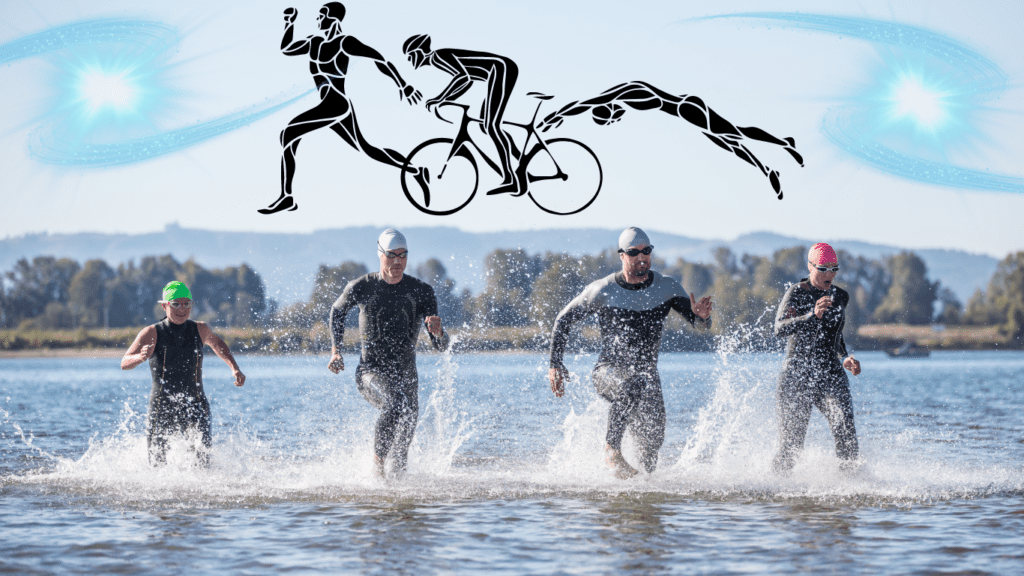
Understanding these fundamentals of swimming, cycling, and running is key to how to train for a triathlon effectively. Each discipline requires specific focus and practice, but with dedication and the right approach, you can master all three. Keep your training varied and consistent, and always listen to your body to avoid overtraining and injuries. By building a solid foundation in each discipline, you’ll be well-prepared to tackle your triathlon with confidence.
Beginner Triathlon Training Schedule: 8-Week Plan:
| Week | Swimming | Cycling | Running |
|---|---|---|---|
| 1 | 2 x 200m (technique focus) | 2 x 5km (easy pace) | 2 x 2km (brisk walk/jog) |
| 2 | 2 x 300m (technique + endurance) | 2 x 8km (easy pace) | 2 x 3km (brisk walk/jog) |
| 3 | 1 x 400m (technique) + 1 x 400m (interval: 4x50m sprints) | 1 x 12km (easy pace) + 1 x 6km (interval: 5x1min fast, 2min recovery) | 1 x 5km (easy pace) + 1 x 3km (brisk walk/jog) |
| 4 | 1 x 500m (technique) + 1 x 500m (endurance) | 1 x 15km (easy pace) + 1 x 8km (interval: 6x1min fast, 2min recovery) | 1 x 6km (easy pace) + 1 x 4km (brisk walk/jog) |
| 5 | 1 x 600m (technique + endurance) + 1 x 400m (interval: 4x50m sprints) | 1 x 18km (easy pace) + 1 x 10km (interval: 7x1min fast, 2min recovery) | 1 x 7km (easy pace) + 1 x 5km (brisk walk/jog) |
| 6 | 1 x 700m (technique + endurance) + 1 x 500m (interval: 4x50m sprints) | 1 x 20km (easy pace) + 1 x 12km (interval: 8x1min fast, 2min recovery) | 1 x 8km (easy pace) + 1 x 6km (brisk walk/jog) |
| 7 | 1 x 800m (technique + endurance) + 1 x 600m (interval: 4x50m sprints) | 1 x 25km (easy pace) + 1 x 15km (interval: 10x1min fast, 2min recovery) | 1 x 10km (easy pace) + 1 x 7km (brisk walk/jog) |
| 8 | 1 x 1000m (technique + endurance) + 1 x 700m (interval: 4x50m sprints) | 1 x 30km (easy pace) + 1 x 18km (interval: 12x1min fast, 2min recovery) | 1 x 12km (easy pace) + 1 x 8km (brisk walk/jog) |
Nutrition and Hydration Essentials for Triathlon Training
When it comes to how to train for a triathlon, nutrition and hydration play a crucial role in your performance and overall well-being. As a personal trainer, I’ve seen firsthand how proper nutrition can make a significant difference in an athlete’s training and race day experience. Let’s delve into the essentials of nutrition and hydration for triathletes.
Daily Nutrition forms the foundation of your training regimen. Fueling your body with the right balance of macronutrients (carbohydrates, proteins, and fats) and micronutrients (vitamins and minerals) is essential for optimal performance and recovery. Carbohydrates are your body’s primary source of energy, making up the bulk of your diet. Focus on complex carbohydrates like whole grains, fruits, and vegetables, which provide sustained energy levels. Proteins are crucial for muscle repair and growth, so include lean sources such as chicken, fish, beans, and tofu in your meals. Healthy fats from sources like avocados, nuts, and olive oil support hormone function and aid in nutrient absorption.
Meal planning is key to ensuring you meet your nutritional needs throughout the day. Aim for balanced meals that include a combination of carbohydrates, proteins, and fats, along with plenty of fruits and vegetables. Preparing meals in advance can help you stay on track, especially during busy training weeks. When I started training for triathlons, I found that having healthy snacks like nuts, fruits, and Greek yogurt readily available helped me resist the temptation of reaching for less nutritious options.
As you ramp up your training, pay attention to your race nutrition. Proper fueling before, during, and after training sessions and races can significantly impact your performance and recovery. Before a workout or race, focus on easily digestible carbohydrates to provide quick energy without causing stomach upset. During longer sessions, consume a combination of carbohydrates and electrolytes to maintain energy levels and hydration. Experiment with different foods and drinks during training to find what works best for you. After a workout, prioritize protein and carbohydrates to support muscle repair and replenish glycogen stores.
Hydration is equally important for training and racing. Dehydration can lead to decreased performance, muscle cramps, and fatigue. Aim to drink water regularly throughout the day, especially during hot weather or intense training sessions. During longer workouts and races, consider adding electrolyte drinks to replace lost fluids and minerals. I always remind my clients to listen to their bodies and drink when thirsty, but not to overhydrate, as this can lead to hyponatremia—a dangerous condition caused by low sodium levels in the blood.
When it comes to supplements, it’s essential to approach them with caution. While some supplements can complement your nutrition and training, others may be unnecessary or even harmful. Common supplements for triathletes include protein powders, branched-chain amino acids (BCAAs), and electrolyte tablets. However, always consult with a healthcare professional before starting any new supplement regimen, as they can interact with medications or have adverse effects.
For athletes following special diets such as vegetarian, vegan, or gluten-free, it’s important to pay extra attention to meeting your nutritional needs. Plant-based athletes should focus on incorporating a variety of protein sources, such as beans, lentils, tofu, and quinoa, to ensure they get all essential amino acids. Gluten-free athletes should choose naturally gluten-free whole grains like rice, quinoa, and oats, and be mindful of hidden sources of gluten in processed foods. I often work closely with clients to help them tailor their diets to meet their specific needs while ensuring they get all the nutrients necessary for optimal performance.
In conclusion, nutrition and hydration are critical components of how to train for a triathlon. By fueling your body with the right balance of macronutrients and micronutrients, planning your meals effectively, and staying hydrated, you can support your training efforts and perform at your best on race day. Experiment with different foods and hydration strategies during training to find what works best for you, and remember to listen to your body’s cues. With proper nutrition and hydration, you’ll be well-equipped to tackle the challenges of triathlon training and achieve your goals.
Mental Preparation
As a personal trainer with experience guiding numerous athletes in their triathlon training, I’ve gained valuable insights into the mental aspects of preparing for such a demanding event. Building mental resilience and managing anxiety and stress are integral components of how to train for a triathlon. Let’s delve into some effective strategies to fortify your mental game.
Developing Mental Resilience is paramount for enduring the rigors of training and overcoming setbacks. Triathlon preparation often entails grueling workouts and moments of self-doubt. In my coaching experience, I’ve emphasized the importance of setting clear, achievable goals at regular intervals. Short-term milestones provide immediate gratification, while long-term objectives keep athletes focused on their ultimate targets. By celebrating incremental successes, athletes bolster their confidence and maintain motivation throughout their journey.
Visualization serves as a potent tool for mental preparation. Encouraging athletes to vividly imagine themselves triumphantly crossing the finish line instills a sense of confidence and determination. Visualization primes the mind and body for peak performance, reducing pre-race jitters and enhancing overall focus. Prior to key events or challenging training sessions, dedicating time to mental imagery can cultivate a winning mindset.
Effective management of Anxiety and Stress is crucial for optimizing performance. Pre-race nerves are commonplace among triathletes and can impede performance if not properly addressed. Establishing a pre-race routine that includes relaxation techniques, such as deep breathing or progressive muscle relaxation, can mitigate anxiety and promote a sense of calm readiness. Incorporating mindfulness practices into daily life further equips athletes with the tools to navigate stressful situations with composure.
Triathlon training encompasses both physical and mental challenges. By integrating mental preparation strategies into their regimen, athletes can cultivate a resilient mindset capable of withstanding the demands of competition. Remember, success in triathlon requires not only physical prowess but also mental fortitude. Embrace the journey, stay committed to your goals, and harness the power of your mind to conquer every aspect of how to train for a triathlon.
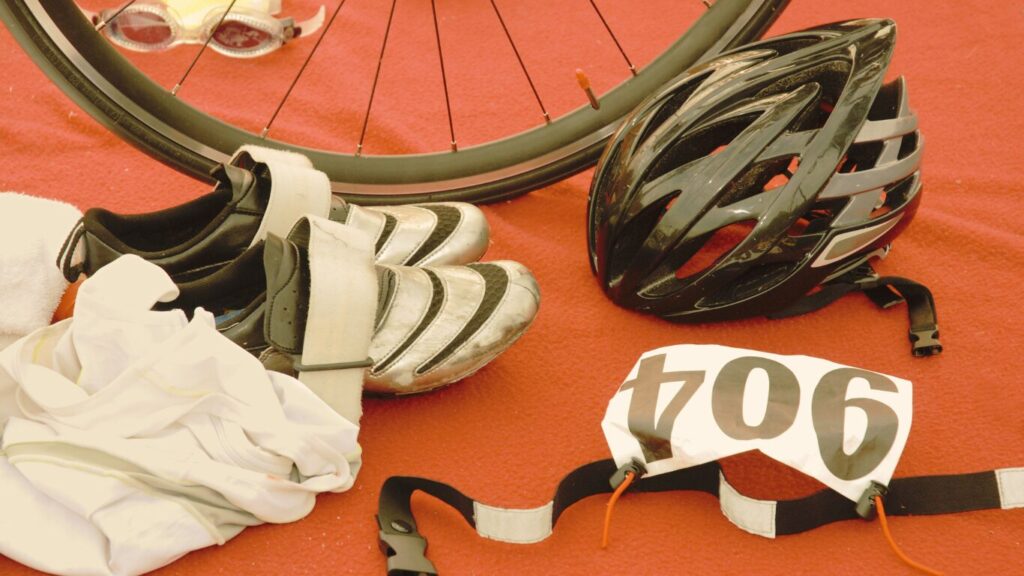
Practical Tips and Hacks for How to Train for a Triathlon
let’s dive into some practical tips and hacks for how to train for a triathlon. As a personal trainer with years of experience, I’ve picked up some valuable insights along the way that can make a big difference in your preparation and performance.
First up, let’s talk about Gear and Equipment. Having the right gear is essential for triathlon success. Whether you’re swimming, cycling, or running, having gear that fits well and performs reliably can make all the difference. Here’s a checklist to ensure you have everything you need for each discipline:
- For swimming: A well-fitted wetsuit, goggles, swim cap, and perhaps some swim fins for training.
- For cycling: A properly maintained bike, helmet, cycling shoes, padded shorts, sunglasses, and a water bottle.
- For running: Supportive running shoes, moisture-wicking clothing, a race belt, and a hat or visor for sun protection.
Now, let’s talk about choosing the right equipment within budget. Triathlon gear can get pricey, but you don’t need to break the bank to get started. Look for quality gear that fits your budget, and prioritize the essentials. Consider buying second-hand gear or looking for deals online to save money without sacrificing quality. Remember, it’s more important to have gear that works well for you than to have the most expensive gear on the market.
Next, let’s discuss Transition Tips. Transitions can be the make or break moments in a triathlon, so it’s important to master them. Transition 1 (T1) is the switch from swimming to cycling, while Transition 2 (T2) is the switch from cycling to running. Here are some tips for mastering transitions:
- Practice your transitions during training to improve speed and efficiency.
- Lay out your gear in a logical sequence so you can find everything quickly.
- Consider using a triathlon-specific transition bag to keep your gear organized and easily accessible.
- Visualize your transitions before race day to mentally prepare and streamline your process.
Now, let’s talk about organizing your transition area. Arrive at the transition area early on race day to claim a good spot and set up your gear. Use a towel or mat to mark your space and lay out your gear in a way that makes sense to you. Keep everything neat and organized so you can find what you need quickly when you’re in a hurry.
Finally, let’s discuss Race Day Tips. Race day can be nerve-wracking, but being prepared can help ease your nerves and set you up for success. Here’s what to expect on race day and how to handle unexpected situations:
- Arrive early to check in, set up your transition area, and warm up.
- Familiarize yourself with the race course, including the swim, bike, and run legs.
- Follow the instructions of race officials and volunteers, and be courteous to your fellow athletes.
- Stay hydrated and fueled throughout the race, and listen to your body’s signals.
- Be prepared for unexpected situations like equipment malfunctions or changes to the course. Stay calm, assess the situation, and make the best decision you can in the moment.
So there you have it, some practical tips and hacks for how to train for a triathlon. With the right gear, efficient transitions, and a prepared mindset, you’ll be ready to tackle whatever race day throws your way.
Real-Life Stories and Interviews: Tales of Triumph and Transformation
Triathlon training is not just about physical endurance; it’s also a journey of self-discovery, resilience, and triumph. Through real-life stories and interviews with first-time triathletes, we witness firsthand the transformative impact of learning how to train for a triathlon.
Emma’s Journey: Overcoming Doubts and Achieving Success
I recently had the pleasure of chatting with Emma, a first-time triathlete who embarked on her triathlon journey with determination and grit. As we sat down over coffee, Emma shared her experience with me, offering valuable insights into the highs and lows of training for and completing her first triathlon.
Emma’s journey began with a simple desire to challenge herself and step out of her comfort zone. Having always been an avid runner, she felt a sense of curiosity and intrigue about the world of triathlons. With the support of friends and family, she decided to take the plunge and sign up for her first race—a sprint triathlon in her local community.
The training process was both exhilarating and daunting for Emma. As a busy professional with limited experience in swimming and cycling, she faced numerous obstacles along the way. From mastering the intricacies of open water swimming to fine-tuning her cycling technique, Emma poured her heart and soul into her training regimen, pushing herself to new limits with each passing day.
Despite her dedication, doubts crept in from time to time. Emma questioned her abilities and wondered if she had what it takes to complete the race. However, with the support of her coach and fellow triathletes, she found the strength to persevere, embracing each challenge as an opportunity for growth.
Race day arrived, and Emma found herself standing on the shore of the swim start, heart pounding with anticipation. As the horn sounded and she dove into the water, a rush of adrenaline surged through her veins. The swim leg was tough, but Emma pushed through, drawing upon her months of training to propel herself forward.
Transitioning to the bike leg, Emma felt a surge of confidence wash over her. The wind whipped through her hair as she pedaled with determination, soaking in the beauty of the scenic course. With each passing mile, her doubts faded away, replaced by a sense of exhilaration and freedom.
Finally, it was time for the run—a discipline where Emma felt most at home. As she pounded the pavement with steady strides, she couldn’t help but smile, overcome with a sense of pride and accomplishment. Crossing the finish line, Emma was greeted by cheers and applause from spectators, her eyes shining with tears of joy.
Reflecting on her journey, Emma shared some valuable lessons she learned along the way. She discovered the importance of perseverance, resilience, and the power of community. Through the ups and downs of her triathlon training, she emerged stronger and more confident than ever before, ready to tackle whatever challenges life throws her way.
Jake’s Tale: Embracing the Journey and Celebrating Progress
Next, let me introduce you to Jake, another first-time triathlete who embarked on his triathlon journey with a sense of excitement and determination. Sitting down with Jake over a post-race meal, he shared his story with me, offering valuable insights into the transformative power of triathlon training.
For Jake, the decision to train for a triathlon was born out of a desire to push his limits and challenge himself in new ways. Having dabbled in running and cycling in the past, he felt drawn to the idea of combining multiple disciplines into one epic race experience. With the encouragement of friends and family, he took the plunge and signed up for his first sprint triathlon.
The journey was not without its hurdles for Jake. As a self-proclaimed “weekend warrior,” he struggled to find balance between training, work, and family commitments. Early morning swim sessions and late-night bike rides became the norm as he juggled his busy schedule with his newfound passion for triathlon.
Despite the challenges, Jake found solace and strength in the camaraderie of his fellow triathletes. He joined a local triathlon club and quickly bonded with his training partners, sharing laughs, swapping stories, and offering words of encouragement along the way. Together, they formed a tight-knit community that lifted each other up and celebrated every milestone, no matter how small.
Race day dawned bright and early, and Jake found himself standing on the starting line, heart pounding with anticipation. As the race unfolded, he embraced each leg with a sense of determination and grit, drawing upon months of training to propel himself forward. The swim was tough, the bike leg challenging, but with each stroke and pedal, Jake felt himself growing stronger and more resilient.
Crossing the finish line, Jake was overcome with emotion—a mix of exhaustion, elation, and sheer pride. He had accomplished something truly remarkable, pushing his body and mind to new heights and discovering a strength within himself that he never knew existed.
Reflecting on his journey, Jake shared some valuable lessons he learned along the way. He learned the importance of setting realistic goals, staying consistent with training, and embracing the journey, no matter how challenging it may seem. Through the ups and downs of his triathlon training, he discovered a newfound sense of purpose and fulfillment, and he couldn’t wait to see where the road would take him next.
Embarking on Your Triathlon Journey: A Summary and Invitation
As we wrap up our comprehensive guide on how to train for a triathlon, let’s take a moment to reflect on the key insights and lessons we’ve covered throughout our journey together.
From understanding the different types of triathlons to setting realistic goals and creating a personalized training plan, we’ve explored every aspect of triathlon preparation with the goal of empowering you to achieve success on race day.
In our exploration of practical tips and hacks, we’ve delved into essential gear, mastering transitions, and navigating race day logistics—all crucial elements that can make or break your triathlon experience.
Through real-life stories and interviews, we’ve witnessed the transformative power of triathlon training, seeing firsthand how ordinary individuals like Emma and Jake have overcome obstacles, pushed their limits, and emerged stronger and more resilient than ever before.
Now, as you stand on the precipice of your own triathlon journey, I invite you to take the first step with confidence and determination. Whether you’re a seasoned athlete looking to tackle a new challenge or a beginner embarking on your very first triathlon, know that you have the power to succeed.
Remember, how to train for a triathlon is not just about physical fitness—it’s also about mental resilience, goal setting, and embracing the journey every step of the way. So lace up your shoes, hop on your bike, and dive into the pool with enthusiasm and excitement.
And know that you’re not alone on this journey. Triathlon training is as much about community as it is about individual achievement. So reach out to your fellow athletes, join local clubs and training groups, and immerse yourself in the vibrant and supportive triathlon community.
Together, we can inspire, motivate, and support each other as we strive to reach new heights and achieve our triathlon goals. So let’s dive in, push our limits, and cross that finish line with pride and joy.
I invite you to share your progress, celebrate your victories, and connect with your fellow triathletes on this incredible journey. Whether it’s through social media, local meetups, or online forums, let’s come together as a community and celebrate the joy of triathlon training.
So what are you waiting for? The road to triathlon success awaits, and the journey begins now. Embrace the challenge, seize the opportunity, and let’s make every moment count as we strive to become the best athletes—and the best versions of ourselves—that we can be.
Together, let’s make every stroke, pedal, and stride count as we embark on this epic adventure called triathlon training. The finish line is waiting, and the glory of crossing it awaits us all. So let’s dive in, embrace the journey, and make our triathlon dreams a reality.
I’ll see you out there on the course. And remember, no matter how tough the road may seem, always keep pushing forward, because the sweet taste of victory awaits those who dare to dream and believe in themselves.
Until then, happy training, and may your triathlon journey be filled with joy, growth, and endless possibilities. Let’s make every moment count and celebrate the incredible journey ahead.
Triathlon awaits. Are you ready to dive in?


